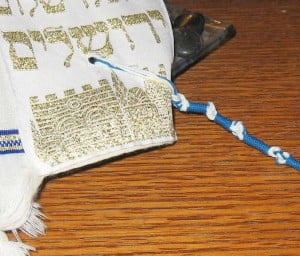In Deuteronomy 22 :12 and Num.15:37-40; “Speak unto the children of Israel, and bid them that they make them fringes in the borders of their garments throughout their generations…and it shall be unto you for a fringe, that ye may look upon it, and remember all the commandments of the Lord.”
Num.15:37-40; “Speak unto the children of Israel, and bid them that they make them fringes in the borders of their garments throughout their generations…and it shall be unto you for a fringe, that ye may look upon it, and remember all the commandments of the Lord.”
In Numbers 15:38 the word translated border or corner is a Hebrew word which can also be translated wings as it is some seventy-six times in the biblical text.
For this reason, the corners of the prayer shawl are often called wings. Each tzitzit consists of five double knots and eight threads, a total of thirteen elements. This number added to six hundred, the Hebraic numerical value of the word tzitzit points to the six hundred and thirteen commandments of the Torah.
As the Atorah was placed over the head, it formed his own tent. WINGS of the garment were formed when the arms were held out. For this reason, the corners of the prayer shawl are often called “wings.”
During the first century there were several traditions associated with the tzitzit concerning Messiah. One was that these knotted fringes possessed healing powers. Certainly the woman with the issue of blood knew of these traditions, which would explain why she sought to touch the hem (the wings) of Jesus’ prayer garment. The same word used in Numbers 15:38 for corner is used in Malachi 4:2 for wings.  In Jesus’ day, Jewish men wore a simple tunic both at home and at work. When appearing in public, they would cover their tunic with a large rectangular cloth which draped over the shoulder and fell to the ankles. This cloth was called a tallit and served as protection from cold and rain. Hanging from the end of each of its four corners (wings) was a tzitzit in obedience to the biblical command. In biblical times the Jewish men wore the prayer shawl all the time — not just at prayer.
In Jesus’ day, Jewish men wore a simple tunic both at home and at work. When appearing in public, they would cover their tunic with a large rectangular cloth which draped over the shoulder and fell to the ankles. This cloth was called a tallit and served as protection from cold and rain. Hanging from the end of each of its four corners (wings) was a tzitzit in obedience to the biblical command. In biblical times the Jewish men wore the prayer shawl all the time — not just at prayer.
TAL-ITH contains two Hebrew words; TAL meaning tent and ITH meaning little. Thus, you have LITTLE TENT. Each man had his own little tent. Six million Jews could not fit into the tent of meeting that was set up in the Old Testament. Therefore, what was given to them was their own private sanctuary where they could meet with God. Each man had one! His Prayer Shawl or Talith. They would pull it up over their head, forming a tent, where they would begin to chant and sing their Hebrew songs, and call upon God. It was intimate, private, and set apart from anyone else — enabling them to totally focus upon God. This was their prayer closet!